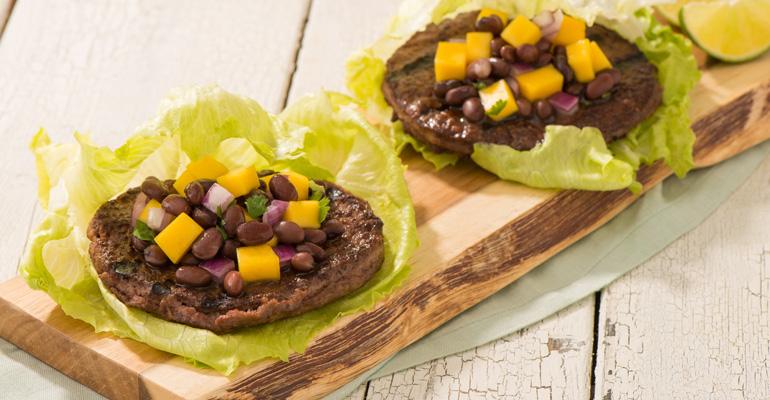Sponsored by AdvancePierre® Foods
Culinary trends may come and go, but the popularity of the nation’s most beloved sandwich, the hamburger, seems to increase by the day.
There’s simply no end in sight to the burger's evolution, reinvention and re-categorization. In recent years, entire concepts based on the idea of making burgers simple again by limiting toppings and bun choices have emerged and expanded. By comparison, others have met with similar success by piling burgers sky high with ingredients commonly seen on Asian and Mexican menus.
Even the better-beef trend has trickled down from fine-dining restaurants to quick-service and fast-casual chains as Certified Angus Beef®, grass-fed and antibiotic-free burgers now are offered for single-digit prices.
But the sandwiches themselves aren’t the only signs of the burger’s unflagging march forward. Cooking methods are changing to hasten throughput, and fully cooked patty options are increasing. Chefs are choosing widely varied cuts of meat to achieve precise fat-to-lean ratios which give their burgers a signature taste, and even the mere shaping of what basically is a flat disc of meat is being tweaked to yield increased tenderness.
“A lot of competition right now is focused on creating new and interesting flavor combinations,” says James Walker, president of operations, development and marketing at Johnny Rockets. “We do some of that, too, but we’re focused mostly on four basic elements: quality of beef, quality in the ratio of ingredients, quality seasoning and a quality cooking method.”
That fourth element led the 394-unit chain to roll out a weighted clamshell burger cooker which applies direct heat to the top and bottom of the burger. The change reduced cook times from nearly five minutes to just over a minute. Without having to smash the meat manually on the grill and then flip it to cook the opposite side, Walker says the finished product has much better mouthfeel.
“We’ve learned that the less you handle a burger, the better the product,” he says.
Some restaurants are slashing cooking times by using pre-cooked patties. Products like The PUB® Steak Burgers from AdvancePierre — a supplier of burger products to the foodservice industry — are flame grilled for added flavor and then reheated on premise. Such precooked products increase food safety, increase speed of preparation, clean up, and guarantee consistent great taste every time vs. patty prepping by hand.
Leadership at MOOYAH Burgers, Fries and Shakes upgraded its meat to Certified Angus Beef® to remain in step with improving quality across the fast-casual segment. Michael Mabry, MOOYAH president and chief operating officer, says the 100-unit chain also realized its core customers were shifting their choices from personal customization of their burgers to combos created by the brand.
“Our brand was built on customization, and we rode that hard for nine years,” Mabry says. But with the recent introduction of its Favorites menu, made up of a blend of 10 top-performing LTOs such as The Double Diablo (beef, pepper cheese, hot sauce and jalapeno slices) and regular menu items, “We found that as many as 70 percent of customers are ordering off that in our new restaurants. It’s also just a list they can look at quickly and choose from.”
When it comes to ingredient innovation, independents are leading the way with international flavors. Who needs lettuce when you can have spicy kimchee, or ketchup when there’s gochujang on hand? Departure, a Pan-Asian restaurant in Denver, serves a Wagyu bulgogi burger with sweet onion, fried egg, butter lettuce and ssamjang — a spicy Korean dipping sauce. Similarly, at Warehouse in Charleston, South Carolina, the Walk of Shame Burger includes two dry-aged beef patties topped with house-made kimchee, Korean barbecue sauce, red curry aioli, American cheese and a fried egg.
“Warehouse has a great late-night bar crowd, so we serve the Walk of Shame at Sunday brunch,” says executive chef Emily Hahn. The meat is a blend of chuck, brisket and short rib. Acknowledging that the term “walk of shame” elicits some unsavory connotations, Hahn laughs and adds, “Okay, it’s shamefully delicious. It’s sloppy and funky and puts so many flavors in your face — just shamefully good.”
But independent operators are not the only ones getting a little edgy with their burgers — chains are experimenting as well. Burger King’s Angry Whopper LTO got even hotter last year with the addition of a hot sauce-infused bun. And McDonald’s continues to experiment with multiple flavor extremes with its spicy Pico Guacamole Burger, and its sweet and savory Maple Bacon Dijon Burger.
George McKerrow Jr., co-founder and chief executive of Ted’s Montana Grill, says the 47-unit casual concept sells plenty of unique burgers, many of which are made with the chain's signature bison meat. One example he mentions is its Canyon Creek option, garnished with cheddar, bacon, jalapeño, blackberry jam and a fried egg. Yet, when it comes to burgers, he says classics outsell newcomers.
“We’ve moved along as trends have gotten more sophisticated and people want more flavor and uniqueness, and we know things like Sriracha and jalapeño and guacamole are hot,” says McKerrow. “But at the end of the day, our top sellers are cheeseburgers and bacon cheeseburgers. So we cater to both.”

